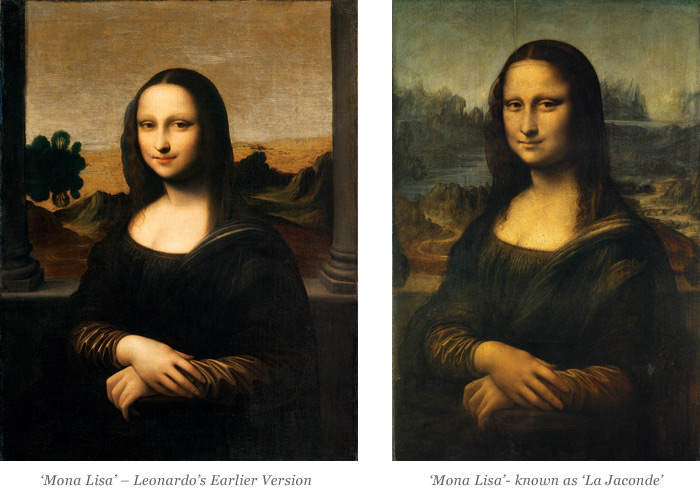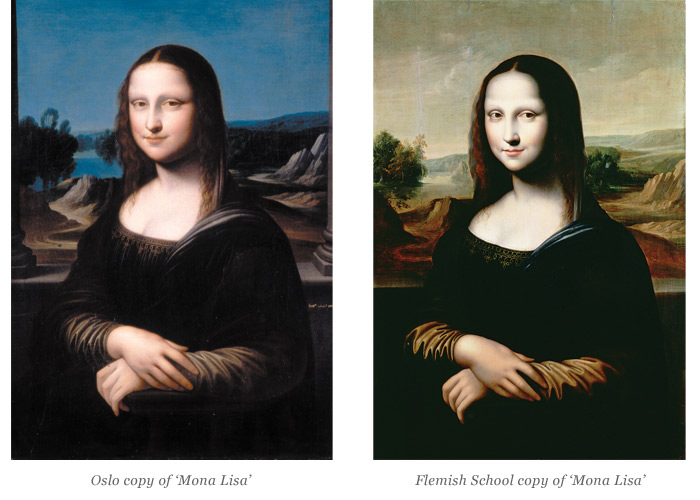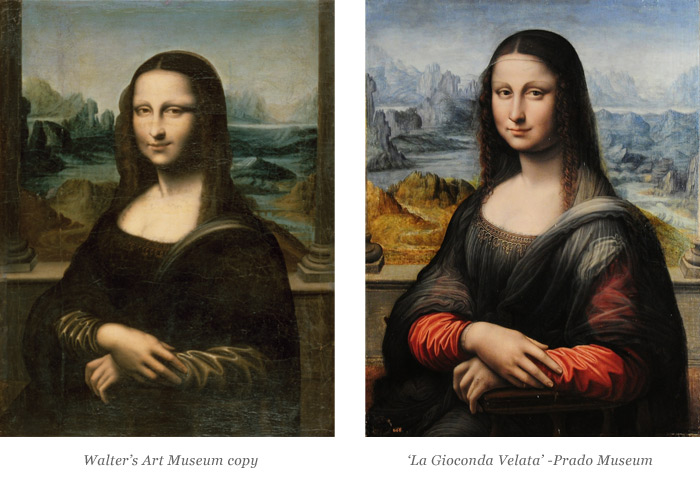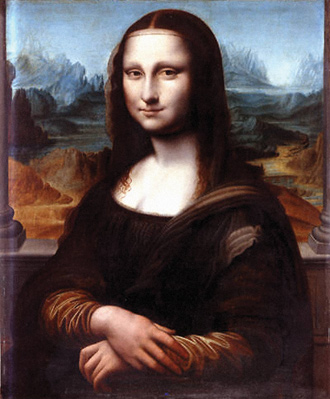As mentioned, there are literally dozens of copies and variations of the Mona Lisa; some good, and some less so. It is simply neither practical nor possible to analyse each one in this publication, and make a fair comparison with either of the originals.
Some worth mentioning include copies in the Hermitage, St. Petersburg; the Walker Art Gallery, Liverpool; the privately-owned copy known as the Vernon ‘Mona Lisa’, that was in the U.S.A.; a copy reputed in the collection of the Earl of Wemyss, in the U.K.; and another in Salzburg. Copies with a similar landscape to the ‘Earlier Mona Lisa’, apart from the one in Oslo, are attributed to Joos van Cleve, Gabriel Ferrier, and others. Interesting copies are also in the Alte Pinakothek, Munich; the Luchner Collection, Innsbruck; and the Musee des
Beaux-Arts, Tours.
In addition, five other prominent paintings have been herewith selected for discussion, and are placed for comparison alongside the two originals.




The Reynolds ‘Mona Lisa’
Oslo ‘Mona Lisa‘
This painting is an almost exact copy of the ‘Earlier Mona Lisa’, and it provides a window in to how certain sections of the ‘Earlier Mona Lisa’, such as the far background landscape and the sky, could have looked.
While the near Tuscan background is almost identical, along with the low rolling hills in the distance, the open sky, the cluster of trees reflected in the blue water on the left reveals the probable intended landscape of the original. Furthermore, the conspicuous flanking columns in the Oslo painting are critical elements that could only have had their origin in the ‘Earlier Mona Lisa’. Other main details of the composition: the shadows on the balcony ledge; the omission of the bridge on the right; the lighting on the neck, and more; all relate directly and solely to the ‘Earlier Mona Lisa’.
The existence of this painting is another major element pointing to the ‘Earlier Mona Lisa’ having been an original painted by Leonardo. After all, why would an artist copy a copy?
According to information provided by the museum, this painting was one of its first acquisitions. It was bought in 1837 in Copenhagen at the sale of the Conferensraad Frederick Bugge collection. Before that it had belonged to the Perrier collection (on the back of the canvas is noted: “Collection de M. Perrier”). It is thought that it came to Denmark via the Parisian dealer Suell shortly after 1800.
The signature: BERNdo LUINI MDXXV is false. Bernardino Luini was one of Leonardo’s most excellent students. The artist of this copy remains unknown, but the almost plastic waxiness in the appearance of the face displays none of Leonardo’s subtleties; and exudes little or none of the emotion or personality of the subject, a skill that Leonardo mastered. There have been suggestions that it was painted by the 17th Century Flemish-born Philippe de Champaigne, but that artist’s portraiture generally displays considerably more talent.
Flemish School ‘Mona Lisa‘
This 16th Century copy, ascribed to the Flemish School, is clearly based on the ‘Earlier Mona Lisa’. The main clues lie in the composition of the landscape: the rocky outcrops in the right and left foreground; the low hills in the distance; and the two separate clumps of trees greatly resemble the earlier version. The background landscape of the Louvre version is completely different.
Walters Art Museum ‘Mona Lisa‘
Information provided by The Walters Art Museum has dated this painting to between 1630 and 1660. A recent X-ray has revealed that it was executed over a previous work depicting St. Veronica, and that there might be some connection with the 17th Century French artist Simon Vouet. Regardless, this copy of Mona Lisa is not likely to have been by Vouet.
There are traces of a frill edge at the top of the lady’s bodice; a detail that is effectively lost on both of the originals. Such a detail would be the last to be applied by the painter, and the first to be lost in restoration work. The main connection with the ‘Earlier Mona Lisa’ is the inclusion of the columns, but they are depicted without shadow. The shaft of light on her neck is also similar. However, the background, including the bridge, is entirely reminiscent of the Louvre ‘Mona Lisa’.
The Prado ‘Mona Lisa‘
[See: The ‘Prado Mona Lisa’]
The Reynolds ‘Mona Lisa‘
The fame of this painting is derived from the fact that it was once owned by Sir Joshua Reynolds, the distinguished and prolific English portraitist. Reynolds had received the picture from the 5th Duke of Leeds, who was Foreign Secretary at the time. He valued the painting highly. Anecdotally, Reynolds asked the secretary of the French ‘Academie Royale’ whether the Louvre ‘Mona Lisa’ was still in the King’s cabinet: the answer that it was there “but not esteemed or considered as the original” (perhaps because of its poor condition at the time) must have encouraged Reynolds’s opinion that his painting was the original. After Reynolds’s death, the picture was acquired by Sir Abraham Hume, and eventually bequeathed to his grandson, John Hume Cust, son of the 1st Earl Brownlow. The painting was exhibited at the Dulwich Picture Gallery, London, with much publicity, in 2006.
Prior to that, in 2005, it had undergone some technical examinations. It was determined that the wood support, three horizontal boards, had come from two eastern Baltic oak-trees, felled after 1602. The painting largely originates as a direct copy of the Louvre ‘Mona Lisa’. The pillars are wider than in the Louvre version, and there is even a faint trace of shadow on the ledge near the left-hand base. The artist, though unknown, is considered to have been French.